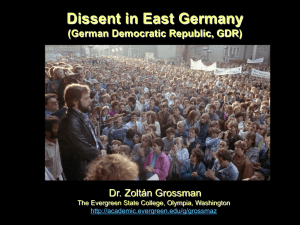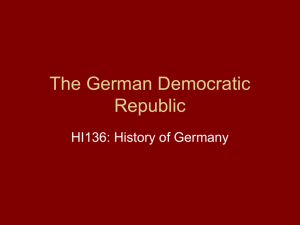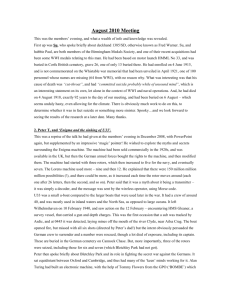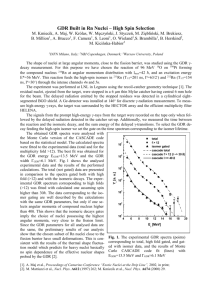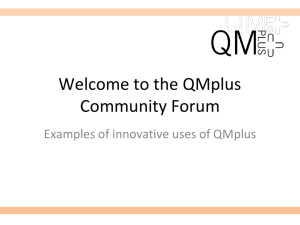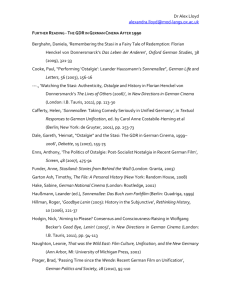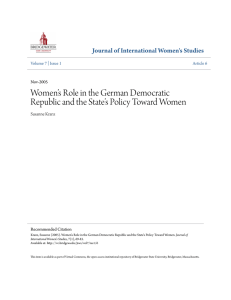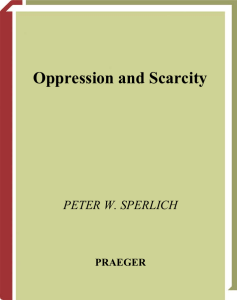HI136 The History of Germany Lecture 17
advertisement
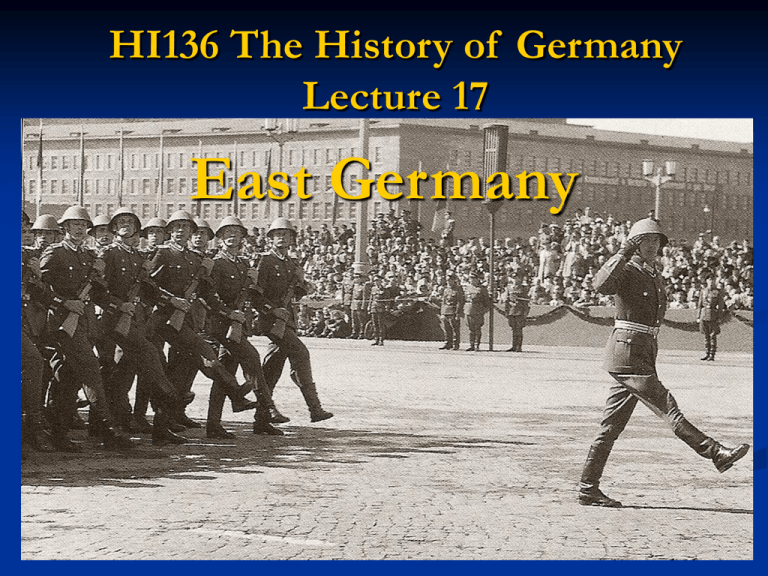
HI136 The History of Germany Lecture 17 East Germany Introduction Debates over the history of the GDR – objective assessments are still difficult to arrive at. Continuity with German history (especially with the Nazi period)? ‘Periodization’ of East German history: Direct occupation by Soviet forces (1945-49) From establishment of the GDR to the building of the Wall (1949-61) ‘Golden Age’ of consolidation & economic liberalization (1961-71) Honecker Period (1971-89) Disintegration & Collapse (1989-90) The Socialist Unity Party (SED) Wilhelm Pieck (KPD) shakes hands with Otto Grotewohl (SPD) on formation of SED, April 1946. June 1945: Soviets legalise political parties. Poor performance of Communists elsewhere in Poland & Hungary leads to pressure for ‘socialist unity’. April 1946: Merger of SPD & KPD in the Soviet Zone to form the SED. 1946 free elections: SED polls 48% SED functions as hub of ‘Antifascist Bloc’ including Christian Democrats and Liberal Democrats, and later National Democrats and Farmers; elections also fought as single Bloc list (aka National Front). 1948-51: SED Stalinised into ‘New-Type Party’; purge of former Social Democrats & loss of parity principle. SED membership: rose from 1.3 (1946) to 2.3 million (1986), including many careerist members. Functionaries (i.e. officials) liked to list themselves as ‘workers’ but had they really become middle-class? ‘Politbureaucracy’ lived sheltered existence in Wandlitz compound, including all mod cons. Politics 1949 Constitution = ‘People’s Democracy’: bi-cameral parliament elected every 4 years, Prime Minister & President. Guarantee of fundamental human rights. In reality people just asked to approve or reject pre-determined distribution of seats, ministries controlled by SED. Walter Ulbricht (1893-1973) Born in Leipzig, joined the Spartacist League in 1918. Co-founder of the KPD, elected as a Reichstag Deputy in 1928. 1933-45: In exile in the USSR. 1949: Appointed Deputy Prime Minister of the GDR. 1950: Became General Secretary of the SED. 1960: Became Chairman of the Council of State. Favoured ‘hard line’ of constructing socialism in half a country rather than pursuing reunification; in 1953 under heavy fire from Politburo colleagues, but ‘saved’ by 17 June uprising. 1960s: Limited economic reforms, but unable to change with the times. 1971: Ousted by ‘palace coup’ by Honecker, with Soviet backing. June 1953 Uprising Growing unrest due to high demands placed on workers and poor living standards. 16 June: building workers on Berlin’s Stalinallee strike for economistic reasons. 17 June am: spontaneous strikes in cities; Berlin strikers march on ministerial district. 17 June pm: more political demands (free elections, national unity); late afternoon Soviet tanks impose martial law. East German explanation: CIAorganised putsch (‘Tag X’) using teenager thugs. West German explanation: people’s revolt against Soviet tyranny. Politics 1949 Constitution = ‘People’s Democracy’: bi-cameral parliament elected every 4 years, Prime Minister & President. Guarantee of fundamental human rights. In reality people just asked to approve or reject pre-determined distribution of seats, ministries controlled by SED. 1954: Return of full sovereignty to the GDR. 1955: Formation of an East German army, foundation of the Warsaw Pact. 1960: President Wilhelm Pieck died – the office of President abolished & replaced by a Council of State (Staatsrat) dominated by the SED. 1968 Constitution = Declared the GDR a ‘socialist state’ & acknowledges the ‘leading role’ of the SED. 1971: Ulbricht replaced by Erich Honecker (1912-94). Hopes for a more liberal regime, but Honecker unwilling to give up the SED’s monopoly on power & politics stagnated under his rule. The Economy 1945-46: Wide-ranging land reform, expropriation of businesses & nationalization of key industries: 40% of industry under state control; 100 hectares (247 acres) of land redistributed to peasants & refugees. GDR at an economic disadvantage compared to the West – had only 30% of industrial capacity, few natural resources & a smaller population. Planned economy focusing on building up heavy industry at the expense of essentials & consumer goods – meat, butter & sugar rationed until 1958, luxury goods like chocolate almost unobtainable. Growth fell from 8% in 1950 to 2.3% between 1960 & 1962. 1963: ‘New Economic System’ – more freedom for producers & consumers = better living standards. 1961-70: Improved growth – the GDR became the strongest economy in the Eastern Bloc. 1980s: Economic stagnation & financial crisis. Emigration Republikflucht (flight from the Republic):500,000 people left for the West between 1949 & 1955. By 1961 1.65 million people had defected. 50% were under the age of 25, most were skilled workers & professionals. 1952: border between East & West closed & fortified. 1961: Berlin Wall built. ‘Shoot to kill’: around 1,000 East Germans killed while trying to escape to the West. Visits to the West strictly controlled. Some liberalization in the 1970s. The Wall led to a more stable labour market & resignation to the way things were. The Police State Stasi HQ in Berlin-Lichtenberg. Ulrich Mühe as Stasi agent Weisler in Das Leben der Anderen (The Lives of Others, 2006). Ministerium für Staatssiicherheit (Ministry of State Security, Stasi) founded as clone of KGB under Soviet occupation. Early on used mainly for counter-intelligence (to keep out or kidnap western spies). Markus Wolf’s Foreign Section scored notable successes in planting moles with West German Chancellor Willy Brandt in 1970s. 1952 Stasi given control of border; later policed the border troops. Poor early warning for 1953 uprising & temporarily demoted from ministerial status. Central Evaluation & Information Group (ZAIG) monitored popular mood. Self-image as pro-active ‘social workers’ or agents of the ‘invisible frontier’; ‘operative missions’ included infiltration & decomposition from within of suspected dissident groups. 1960s: MfS adopts more sophisticated techniques & ‘total surveillance’. Informelle Mitarbeiter (IMs) (‘informal collaborators’ or informants: growing reliance for ‘total surveillance’ on coopted members of public. By the 1980s had as many as 91,000 agents, plus as many as 300,000 civilians informants. Society & Culture Mass organizations extended the reach of the Party into everyday life: Free German Trades Union Federation (FDGB), Free German Youth (FDJ) and Democratic Women’s Association (DFD). Membership not strictly speaking compulsory, but failure to join could hamper employment prospects etc. Religious education banned in schools & replaced with compulsory classes in Marxism-Leninism. Schools & Universities teach history, economics etc. from a Marxist viewpoint. Jugendweihe – ‘coming of age’ ceremony in which children pledged themselves to the Party and the socialist state. 1962: Compulsory 18 months military service for all young men introduced. Strict control of cultural life – ‘Socialist Realism’ – art has an ideological message. Anti-Fascism Buchenwald memorial: unveiled in 1958, this group represents the KPD’s leading role in the resistance, with a (historically dubious) myth of the camp’s self-liberation. Buchenwald was the GDR’s main memorial site for school visits & veterans’ meetings. Marxist-Leninist doctrine always interpreted fascism as an outgrowth of capitalism; therefore antifascism linked to anti-capitalism (big business as Hitler’s stringpullers). Fascism also interpreted as a political class war (mainly v. KPD), rather than racial war (v. Jews); GDR paid no reparations to Israel & anti-Semitic attacks on graveyards persisted. West German Federal Republic viewed as haven of former Nazis, protected by Anglo-Americans (especially in 1950s/60s); antifascism thus had contemporaneous function of anti-westernism (e.g. Berlin Wall officially labelled ‘Antifascist Defence Rampart’). SED leadership (mainly Soviet exiles) had ambivalent attitude to ‘real’ antifascist veterans (marginalised ‘inland’ resisters, dissolved veterans’ organisations). Antifascism an affective moral argument for wartime generation; but younger generations increasingly indifferent to abstract antifascism. Support for the Regime Initial support for the regime – many welcomed an anti-fascist and/or socialist state, land reform & nationalization popular, many optimistic for the future. However, problems of identity: Germans or East Germans? In the 1960s increased acceptance/tolerance of the regime, but little enthusiasm for it. Most people joined the Party in order to get on rather than because they were committed Communists. Increased dissatisfaction in the 1970s & 80s – Churches (one of the few organizations which remained outside SED control) acted as focus & sanctuary for opposition groups; growing environmental movement; liberalization in USSR after 1985 had knock-on effect (but not at state level). Historiography Totalitarian Interpretations A Modernising Dictatorship? Collective Biographies Totalitarian Explanations Popular in 1950s West German interpretations; revival post-1989 Stress illegitimacy of Soviet occupation & East German ‘puppets’ State ideology of ‘socialist personality’ within collective ‘Leading role’ of ruling party enshrined in constitution Stasi secret police State control of economy Control of media Control of economy Berlin Wall as epitome of state control of individual Comparisons drawn with brown dictatorship of NS Breached UN human rights on freedom of travel Also popular with many former GDR citizens; but is this because it denies personal responsibility? Authors: Klaus Schroeder, Der SED-Staat (1998), Eckard Jesse (ed.), Totalitarismus im 20. Jahrhundert (1998), Anthony Glees, The Stasi Files (2003) A Modernising Dictatorship? Complex industrial economy required ‘rational’ not ‘ideological’ elite Economic reforms of 1960s (New Economic System) Special role of intelligentsia in GDR (see dividers on state emblem) Precision engineering from Dresden & Leipzig 1980s gamble on microchip technology (too high investment costs) Welfare dictatorship (Konrad Jarausch) Attempt at decentralisation and incentivisation of economy Technological revolution More university graduates enter party apparatus from 1960s Peter C. Ludz, The Changing Party Elite in East Germany (1968/72) Indirect use of ‘social power’ to predispose groups to choose socialism Full employment, hospitals, education system > fond memories Educational dictatorship (Erziehungsdiktatur)? Party ‘in loco parentis’, knowing what was good for the people Rolf Henrich, The Guardian State (1989); party man turned dissident Collective Biographies Goodbye Lenin (2003): Alex with his allegorical mother/motherland who cannot survive the fall of the Wall. The GDR green man. GDR lasted more than one generation; post-1949 generation ‘born into’ socialism. Are we patronising GDR citizens by treating them all as ‘released prisoners’ & victims? Gaus, Locating Germany (1983): ‘niche society’, relatively normal private life possible behind public conformity. Material culture: 1990s growing interest in popular culture of GDR. Ostalgie/’Eastalgia’: re-issuing of GDR brands (see the Spreewald gherkin episode in Goodbye Lenin); fight to preserve minor symbols of difference (traffic light man). Danger of ‘commodifying’ the GDR past & relativising idealistic motivations.


